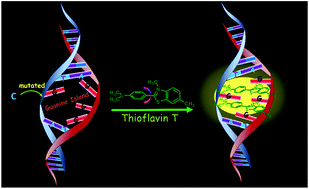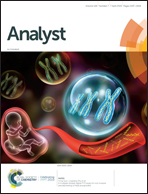Thioflavin T specifically brightening “Guanine Island” in duplex-DNA: a novel fluorescent probe for single-nucleotide mutation†
Abstract
Here, we found that Thioflavin T (ThT) could specifically bind with a G-GGG unit (named as “Guanine Island”) in double stranded DNA (ds-DNA). Through stacking with G base via hydrogen bonds, the rotation of ThT was restricted and concurrently its planarization was enforced. Such a binding mode produced a significantly enhanced ThT fluorescence. Based on this discovery, with ThT as a lighting-up probe for “Guanine Island” in ds-DNA, the fluorescent detection of single-nucleotide mutation (C mutation) was investigated. With C base in target DNA mutating to G, A or T and further hybridizing with a probe DNA containing a GGG unit at the mutated point, ds-DNA including G-GGG, A-GGG or T-GGG islands was formed, respectively. After binding with ThT, C mutation was clearly recognized. With C mutating to G as an example, the detection limit was as low as 3 nM. Importantly, the developed assay could be applied to recognize C mutating to G in a DNA sequence related to dilated cardiomyopathy for diluted human serum. As a sensing unit (“Guanine Island” in ds-DNA lighting up ThT), it is expected to be applied for various biological or environmental systems.

- This article is part of the themed collection: Bioanalytical Sensors


 Please wait while we load your content...
Please wait while we load your content...